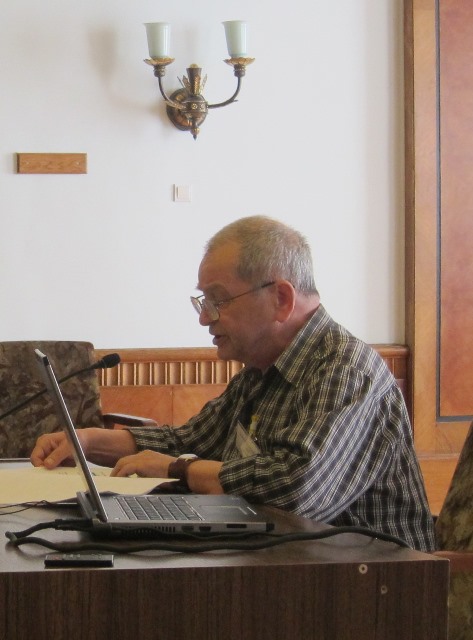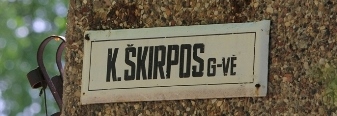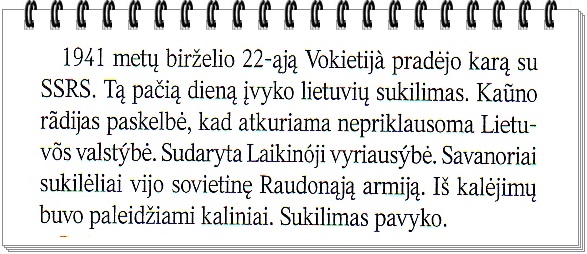O P I N I O N
by Milan Chersonski

Milan Chersonski reads his paper at the Riga conference, 27 May 2013
The following is the authorized English version of the paper read by Milan Chersonski in Riga on 27 May 2013 at the Second International Conference on Holocaust Museums and Memorial Places in Post-Communist Countries.
Milan Chersonski (Chersonskij), longtime editor (1999-2011) of Jerusalem of Lithuania, quadrilingual (English-Lithuanian-Russian-Yiddish) newspaper of the Jewish Community of Lithuania, was previously (1979-1999) director of the Yiddish Folk Theater of Lithuania, which in Soviet times was the USSR’s only Yiddish amateur theater company.
See also the Milan Chersonski section of Defending History.
I
In Eastern European countries occupied by Nazi Germany during World War II there was a phenomenon called “collaborationism”: the cooperation of individuals and organizations with the Nazi occupation regime. In the modern historiography of these countries, events of that fateful time are often presented not by historians, but primarily by right-wing or extreme right-wing politicians, who continue today to convince the public that the collaboration was in fact nothing but a form of struggle for independence, and a kind of resistance to the Nazi regime.
Sometimes this approach to the evaluation of historical events is called whitewashing. The purpose of this manipulative activity is clear: to absolve the erstwhile Nazi collaborators and pro-Nazi national organizations from the responsibility for the crimes against humanity committed during the Nazi occupation, and their countries from responsibility for Nazi crimes.
In Lithuania, special attention of the political “historians” is focused on the events of the first six weeks of the war. That is the time when under the supervision of Nazi Germany’s secret service the “uprising” organized by the pro-Nazi Lithuanian Activist Front (LAF) took place, and the Provisional Government in Lithuania, which existed from 23 June to 5 August 1941, was established. The struggle for the rehabilitation of that “uprising” as well as the activities of the Provisional Government has become a means to unite the right-wing political parties as well as the rightist and the extreme-right NGOs in today’s Lithuania. For example, in Kauno Diena of 21 June 1999 it was written that the uprising by the Lithuanian Activist Front was directed “against Bolshevik Russian imperialism and against the Nazi occupation.”
Some politicians and historians from various Lithuanian NGOs, the media, as well as public research institutions are also involved in reshaping, rewriting, and whitewashing the history of World War II.
II
Let us have a look at the textbook on history for the 5th grade, called Kelias (“The Path”), which was approved by the Lithuanian Ministry of Education and Science on 31 March 2008. We read on page 138:
“On 22 June 1941, Germany started the war against the Soviet Union. On the same day Lithuanians started the uprising. Kaunas radio announced the restoration of the independent Lithuanian state. The Provisional Government was formed. Volunteers and rebels chased the Red Army away. Convicts were released from prisons. The uprising was a success.”
At first glance, seven short sentences provide an objective conveying of information and a concise record of the events of the beginning of the Nazi intervention in Lithuania. But if you look at it in the framework of basic issues, the picture becomes quite different.
First of all, Germany did not “start” the war with the Soviet Union in the usual sense, but suddenly attacked it without any prior notice or ultimatum, making it quite clear that war to the bitter end is the only way to solve the problems between Germany and the Soviet Union.
Secondly, in the textbook there is not a single word indicating that the troops of Nazi Germany invaded Lithuania, and from that moment the Nazi occupation of Lithuania began. Nor is there mention that on that very day Lithuanian towns fell victim to the brutal bombings by the Germans.
Thirdly, the “uprising of Lithuanians” began not on 22 June, but one day after the outbreak of the war between Germany and the Soviet Union, in other words on 23 June. Those were the instructions of the Berlin staff of the “Lithuanian Activist Front.”
Fourthly, the statement that “volunteers and rebels chased the Red Army away,” is to put it mildly, an exaggeration. It is clear to any sensible person that the Red Army was retreating, but not because of blows of small and isolated groups of “volunteer rebels,” but because it couldn’t beat off the superior troops of the Nazi armed forces.
Still, the statement that “volunteers and rebels chased the Red Army away” indicates that the rebels were Nazi collaborators. And an anti-Soviet uprising of the “white armbanders” (as “national partisans” are popularly called in Lithuania) provided the maximum assistance to the Nazi occupation of Lithuania.
Moreover, there is nothing about the beginning of the total extermination of Jews in Lithuania that started on 23 June, from the very beginning of the “white armbander partisans’ uprising.”
Finally, it was not Kaunas radio, but the representative of the Lithuanian Activist Front, Leonas Prapuolenis, who announced from the Kaunas radio center seized by the men with “white armbands” about the establishment of the Provisional Government; he read the LAF proclamation, which said:
“Brothers Lithuanians! Take your weapons and help the German army in the cause of national liberation. […] With confidence and grateful joy meet the marching German troops and provide them with all possible assistance. Long live the friendly relations with the great Germany and its leader Adolf Hitler! Long live free and independent Lithuania!”
(original appeal first published 53 years later in Akiračiai, no. 2, 1994)
A trend of bleaching and whitewashing goes through the history textbooks, becoming more complex as the pupils grow older. But the principle of silencing unwanted facts or any changes in the narrative can also be observed in high school classes.
Young people brought up on such “textbooks” have been holding annual marches on February 16th in Kaunas and on March 11th in Vilnius over the past eight years, where they shout antisemitic nationalist slogans and display modernized Nazi symbols.
III
In the struggle for influence over the “the minds of the voters,” right and extreme right-wing leaders hold festive reburials, with military honors on the official level, of the deceased Lithuanian leaders who had collaborated with the Nazis and then fled from Lithuania at the end of the war.
One of the first leaders to be reburied was Kazys Škirpa, the former Chief of Staff of the independent Lithuanian armed forces and the Ambassador Extraordinary and Plenipotentiary of Lithuania to Germany. Mr. Škirpa was a devoted admirer of Hitler. He coordinated his plans to establish an anti-Soviet guerrilla organization (the “Lithuanian Activist Front”) with the secret service of Nazi Germany.
This is what Mr. Škirpa wrote about the establishing of LAF to Field Marshal Keitel in December 1941:
“It was created by me with the knowledge, and upon approval of German institutions, even before the outbreak of the German-Russian war, and [I] was acting upon a common plan, which I handed to the supreme leadership of the German command (counter-intelligence department) in January 1941. And I did so, giving it [i.e. the LAF ― MC] orders in accordance with the instructions prepared by me as well as the supreme leadership of the counter-intelligence department of the German army, and in accordance with the instructions of certain front-line military institutions.”
Under the leadership of K. Škirpa who fanatically believed in Nazism, the “Guidelines for the Liberation of Lithuania” were developed at the Berlin headquarters of LAF (for the original in Lithuanian, see: Liudas Truska and Vygandas Vareikis. Holokausto prielaidos. Antisemitizmas Lietuvoje. Margi raštai, Vilnius, 2004, the section “Lietuvai išlaisvinti nurodymai” on pp. 245 – 263). One known version of the “Guidelines” is dated 24 March 1941.
The main enemies of Germany, and thus, the enemies of the Lithuanian rebels, according to the author of the “Guidelines” are Communists and Jews. The “Guidelines” repeatedly reaffirm the need to apply extremely severe measures against the Jews:
“It is very important on the occasion to get rid of the Jews […] In order to raise the ideological maturity of the Lithuanian people it is important to strengthen anti-Communist and anti-Jewish actions.”
“If it is found that on the fateful hour of reckoning and revival of Lithuania especially delinquent Jews find possibilities to secretly escape anywhere, it is only the fulfillment of duty of all honest Lithuanians to make their own arrangements for the detention of such Jews and ― in special cases ― to punish them.”
“All movable and immovable property previously disposed of by Lithuanian Jews […] is rightly transmitted mainly to Lithuanians, the most active fighters for the liberation of Lithuania from the Bolshevik and Jewish oppression. Any noticed attempt to destroy or damage such property from the Jewish side will be immediately punished.”
(Liudas Truska and Vygandas Vareikis. Holokausto prielaidos. Antisemitizmas Lietuvoje, Margi raštai, Vilnius 2004, pp. 268-269)
In any case, the German staff did not allow Kazys Škirpa to lead the established Lithuanian Provisional Government, because, according to the German Reich plans Lithuania as a country was doomed to disappear from the map of Europe and become part of the Ostland province. Škirpa was placed under “house arrest.”
In 1995 the children and grandchildren of the organizer of the “white armbander uprising” and the author of the antisemitic “Guidelines for the Liberation of Lithuania” Kazys Škirpa brought his ashes from the United States to Lithuania. He was solemnly reburied at the Petrašiūnai memorial cemetery in Kaunas. The memorial speeches on the grave of a former Abwehr agent were given by the then Prime Minister of Lithuania Adolfas Sleževičius and the Defense Minister Linas Linkevičius (now Minister of Foreign Affairs). The Lithuanian national anthem as well as the military salute followed.
The reburial ceremony was thus an act of recognition, by the modern Lithuanian state, of Škirpa’s merits to the people of Lithuania. One of the most affluent and most notable monuments in the entire Petrašiūnai cemetery, which has always attracted visitors’ attention, was put on his grave.
Streets in Vilnius and Kaunas are named after Kazys Škirpa.

“Škirpa Alley” (K. Škirpos aleja) adorns the building of the prestigious Museum of Applied Arts in central Vilnius

“Škirpa Street” (K. Škirpos gatvė) in Kaunas
The house (no. 25) on Kaunas’s Gedimino Street there is a plaque, unveiled on 23 November 2001, that reads:
“In this house in 1925 – 1926 worked the creator of the Lithuanian Armed Forces, the participant in battles for independence, the Constituent Seimas member, the Head Chief of Staff, a diplomat, founder and leader of the Front of the Lithuanian Activists, the President of the Provisional Government of Lithuania, Knight of the Cross of Vytis and Colonel of the General Staff
Kazys Škirpa
(1895 – 1979)”
But one of the “achievements” of Mr. Škirpa is missing on the plaque: among the main goals of the June 1941 uprising, according to him, was the need to get rid of Lithuanian Jews. Once and for all. The rebels under the leadership of the Nazis did get rid of the Jews. And Lithuania is a sad leader in Europe in that respect. During the years of World War II 96% of the Jewish population, which in 1940-1941 constituted some 240,000 people, were killed in Lithuania. This is the highest percentage of Jews killed in any country in Europe.
IV
On 12 September 2000, on the eve of the 47th anniversary of the destruction of the Vilna Ghetto, the Lithuanian Seimas voted for the legitimacy of the 1941 Provisional Government of Lithuania.
On that day, at the session of the 141 members of the Seimas, 89 people were missing, that is, the law was adopted by 36% of MPs.
“Quite incidentally” among the absentees were the chairman of the Seimas, Vytautas Landsbergis, as well as his closest ally, the then chairman of the Seimas Human Rights committee Emanuelis Zingeris, the only Jew in the Seimas. He has not been a member of the Jewish Community of Lithuania since 1997 but is often referred to abroad as leader of the Jewish community of Lithuania.
Lithuania’s President Valdas Adamkus refused to take responsibility for this law. Keeping in mind Mr. Landsbergis and Mr. Zingeris, he said: “I do not know the reasons why these MPs did not vote and did not express their position in the Seimas,” adding that
“a group of MPs have started writing history with the help of laws, not paying attention to the negative findings of the Lithuanian Institute of History and the Lithuanian Center for the Study of Genocide and Resistance.”
Vytautas Landsbergis also wanted to not take responsibility for the legitimacy of the Provisional Government, and on 19 September 2000, he introduced a draft resolution of the Seimas, directing it to consider the new law as being “in the process of discussion.” The obedient majority of the Seimas voted for that proposal; the law, “adopted in the first reading,” was sent to the archives where it is waiting already for further “readings” for thirteen years.
V
In May 2012, the remains the Acting Prime Minister of the Provisional Government of Lithuania Juozas Ambrazevičius were delivered from Connecticut to Kaunas and buried there with full state honors. This meant, in point of fact, an implicit recognition of the legitimacy both of Juozas Ambrazevičius and the Provisional Government itself.

May 2012 at Vilnius airport: Welcoming with full honors the remains of J. Ambrazevičius
The six-week tenure of the Provisional Government in 1941 was marked by the adoption of several resolutions, which are essentially indistinguishable from Hitler’s antisemitic doctrines towards Jews. This can easily be seen if one looks at the collection of the Provisional Government’s minutes (Lietuvos laikinoji vyriausybė: posėdžių protokolai, at: (Parengė dr. Arvydas Anušauskas, 2001 m. LGGRTC).
In minute no. 5, from 27 June 1941, it is recorded that
“Minister Žemkalnis reported on the unusually brutal massacres committed against Jews in Kaunas, at the Lietūkis garage. It is resolved that, despite all the measures to be taken against the Jews for their Communist activities and harm caused to the German army, the partisans and individual citizens should avoid public executions of Jews.”
Minute no. 6 of 30 June 1941 (on the establishment of the Lithuanian Police Battalion) reads:
“1. To provide a 10-day advance on the basis of 7,492 rubles per day on the membership of the battalion; in the future to allocate funds for this purpose in accordance with estimates to be provided.
“2. To approve the establishment of the Jewish concentration camp, instructing its guidance and creation to Vice Minister of Communal Utilities Mr. Švilpa in cooperation with Mr. Colonel Bobelis.”
The concentration camp was established at Kaunas’s Seventh Fort. Using money of the Provisional Government, the Lithuanian battalion there started the “regulated” destruction of Jews. From the establishment of the concentration camp and until it was closed on 10 September 1941, the battalion servicemen killed about five thousand Jews of Kaunas. On 1 August 1941 ― four days prior to the termination of its activities ― the Provisional Government of Lithuania’s “Regulation on Jews” received approval. It is the Lithuanian version of the Final Solution of the Jewish question.
Today some “researchers” and “politicians” describing the history of World War II in the Republic of Lithuania try to whitewash such figures, such events, and such facts.
